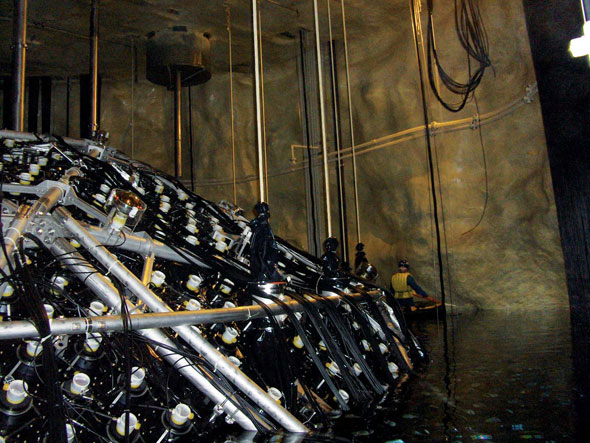A scrub+ for SNO+
Imagine a house-sized acrylic fishbowl inside a giant, shiny, disco-ball-like sphere, suspended in a cavern as tall as a 10-story building. Now imagine climbing around inside that pitch-dark fishbowl with a squeegee and a flashlight.
Peter Skensved does that once or twice a week.
For the past few months, the Queen's University physicist has tackled dirt, cracks in glue joints, rips in liners, and dead photomultiplier tubes as he helps to convert the SNO particle detector in Ontario, Canada, for a new project called SNO+, pronounced "snow-plus."
 |
| Photo courtesy of Peter Skensved |
SNO stands for Sudbury Neutrino Observatory, an experiment in a working mine two kilometers below ground. Its transparent, spherical detector was filled with heavy water that gave off Cherenkov light when a neutrino passed through. Photomultiplier tubes picked up these light signals and passed them on to computers for analysis.
For its successor, SNO+, scientists are draining the detector. They will refill it with a scintillating liquid called LAB, or linear alkyl benzene. This will allow detection of neutrinos with much lower energies that come from the sun, exploding stars, or natural radioactive decays in the earth.
To take full advantage of this, Skensved says, the detector has to be as free of contaminants as possible. For SNO, "clean" meant keeping levels of uranium and thorium contaminants in the water a factor of a billion lower than those found in dirt and one million times lower than on the acrylic vessel's surface. Essentially, the allowable contaminant amount could equal the size of one gram of dust embedded on the vessel.
For eight-to-10-hour stretches, he sits in a rubber boat floating in the old water and peers at, patches, and scrubs the cavity's plastic liner and the detector's acrylic panels. He rides the water down as it slowly drains, exposing new sections for inspection. He removes an oil film left from a water pump seal break and searches for signs of material stress, such as bubbles, hairline fractures, or holes. He'll do the same thing for the accessible photomultiplier tubes.
When he flicks on his flashlight, reflectors in the photomultiplier tubes beam light in all directions.
"There is so much light being reflected back at you that some people get a little seasick," he says.
Scientists use high-pressure, ultra-pure-water sprayers and squeegees on really long poles to scour parts of the interior walls.
The detector must be scrubbed inside and out, but its curved, ultra-smooth walls thwart climbing. So Skensved is working out a plan to reach difficult spots: scaffolding, a seat lowered by rope, or floating docks.
When the detector is almost ready to operate, Skensved will hand-sand radon residue off the walls, likely underwater to prevent too much radon from getting in the air.
After the contaminated water drains away, the detector will be ready for the pure new liquid and physics results to come.
Tona Kunz
Click here to download the pdf version of this article.






